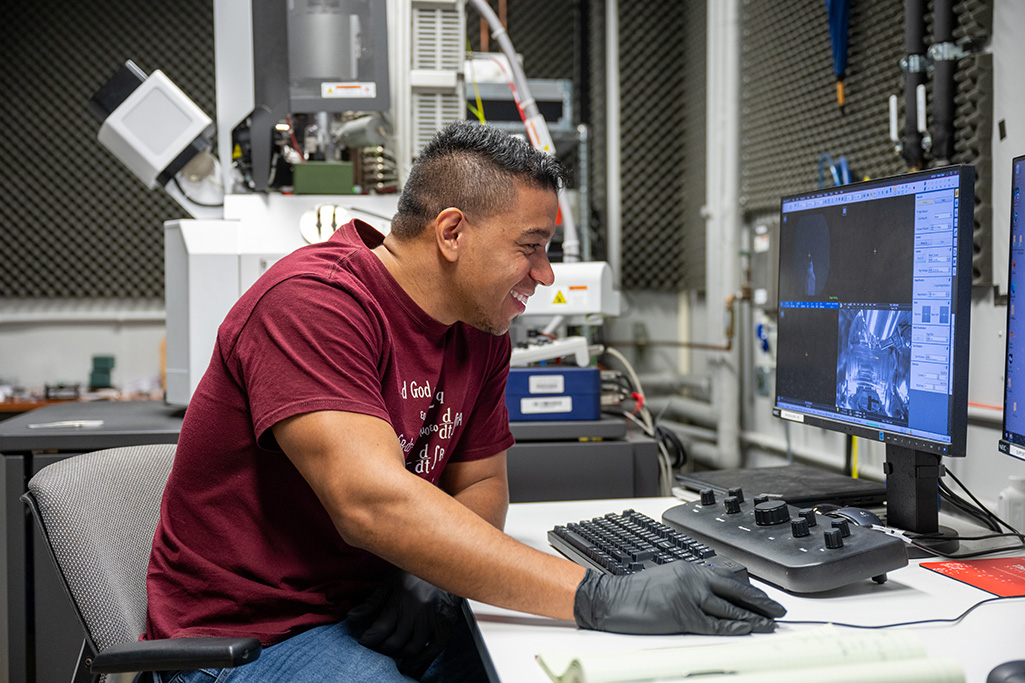Scientific Achievement
High-temperature superconducting (HTS) magnets made from multi-layered rare-earth barium copper oxide (REBCO) conductors are crucial for achieving commercially viable magnetic confinement fusion, which offers an attractive alternative to existing energy sources. However, REBCO conductors are vulnerable to the radiation they will encounter in a future fusion reactor; specifically, irradiation-induced gas production can impair their superconducting qualities.
Now, a team of American and Japanese researchers has conducted one of the first formal investigations into the phenomenon of gas production in future compact fusion reactors. The study identified several key limitations to the survivability of REBCO tape in the intense radiation fields expected in the reactor, including physical swelling and deterioration of the critical current.
The team included researchers from the Accelerator Technology & Applied Physics Division at the U.S. Department of Energy’s Lawrence Berkeley National Laboratory (Berkeley Lab), in collaboration with colleagues from the University of California, Berkeley, Florida State University, Tallahassee, the Applied Superconductivity Center, Tallahassee, High Energy Accelerator Research Organization, Tsukuba, Japan, Type One Energy, and Los Alamos National Laboratory.
Significance and Impact
The research has important implications for the rapidly growing magnetic confinement fusion community. Along with several recent studies, the findings from this research highlight critical concerns—some already well-known in the fission power industry—that, while not deal-breakers, are important areas to carefully consider moving forward. Specifically, the fabrication techniques used for these second-generation high-temperature superconductors were developed for research magnets not designed to withstand ultrahigh-dose environments like those near a fusion reactor’s core.
Research Details
A union of simulation and experimentation

Depiction of simulated geometry used to assess gas deposition via energetic recoil of transmutation products directly into the REBCO layer. White arrows visualize the distance these products traveled to arrive at the REBCO layer from each of the discretized slabs of copper and Hastelloy. The sum of contributions of each slab was used to compute total flux and lifetime fluences/He concentrations.
The researchers used the expected neutron spectrum at the magnet location of an “Affordable Robust Compact”-like reactor—a conceptual tokomak fusion reactor design developed by researchers at the Massachusetts Institute of Technology—to simulate the rate of protons and alpha particles produced from nuclear reactions with the atoms in REBCO-coated conductors. These “secondary ions” harm materials because they capture electrons after recoiling from the nucleus and accumulate within the material, eventually causing swelling and mechanical weakening. The portions of each secondary ion flux with enough energy to recoil into the superconducting layer were then calculated to estimate gas production rates, as well as the resulting lifetime fluences and densities. Lastly, Helium-Ion Microscope and Tandem Accelerator implantations were performed to simulate this gas production, followed by characterizations of the microstructural and electromagnetic effects.
High fluxes and interesting swelling

Side-by-side comparison of the swelling rates of both SuperPower’s gadolinium-based and Fujikura’s europium-based superconducting REBCO layers.
The way the helium flux was modeled to resolve itself into the superconducting layer after the typical 30-year projected lifetime of the reactor was consistent with known causes of swelling in other materials. Direct helium implantation on this multifaceted tape resulted in swelling disparities between layers, and transmission electron microscopy showed unusual elastic swelling behavior and bubble development. Negligible reductions in the critical temperature were observed, but the critical current was halved under the most extreme conditions.
However, ions can only mimic neutrons to a certain extent. As a result, in a future paper, the researchers will present a similar microstructural study, now focusing on neutron-irradiated tapes, comparing fission-like neutrons with the more fusion-like breakup target neutrons produced by Berkeley Lab’s 88-Inch Cyclotron.
Contact: Christopher Reis
Researchers: Chris Reis, Chase Gesteland, Kooknoh Yoon, and Lee Bernstein (Berkeley Lab and the University of California, Berkeley); Tengming Shen and Soren Prestemon (Berkeley Lab); Mehdi Balooch, Peter Hosemann, and Ella Yarossi (University of California, Berkeley); Masami Iio, Toru Ogistu, and Makoto Yoshida (High Energy Accelerator Research Organization); Jonathan Lee (Florida State University, Tallahassee, and Applied Superconductivity Center); Hamilton Parrish (University of California, Berkeley, and Type One Energy); Masami Lio (High Energy Accelerator Research Organization); and Yongqiang Wang (Los Alamos National Laboratory).
Funding: This work was supported by the U.S. Department of Energy through the Office of Fusion Energy Sciences, Los Alamos National Laboratory, the National High Magnetic Field Laboratory, the University of California, Berkeley’s Fung Institute for Engineering Leadership Master of Engineering degree program. This study was based on work conducted in Japan under the GIMRT Program of the Institute for Materials Research, Tohoku University.
Publication: Chris Reis, Chase Gesteland, Mehdi Balooch, Kooknoh Yoon, Jonathan Lee, Masami Iio, Toru Ogistu, Makoto Yoshida, Hamilton Parrish, Ella Yarossi, Tengming Shen, Yongqiang Wang, Lee Bernstein, Soren Prestemon, and Peter Hosemann. “Irradiation-induced gas production in REBCO-based magnet materials used for future compact fusion reactors,” J. Appl. Phys. 137, 235101 (2025), https://doi.org/10.1063/5.0263824
For more information on ATAP News articles, contact caw@lbl.gov.
